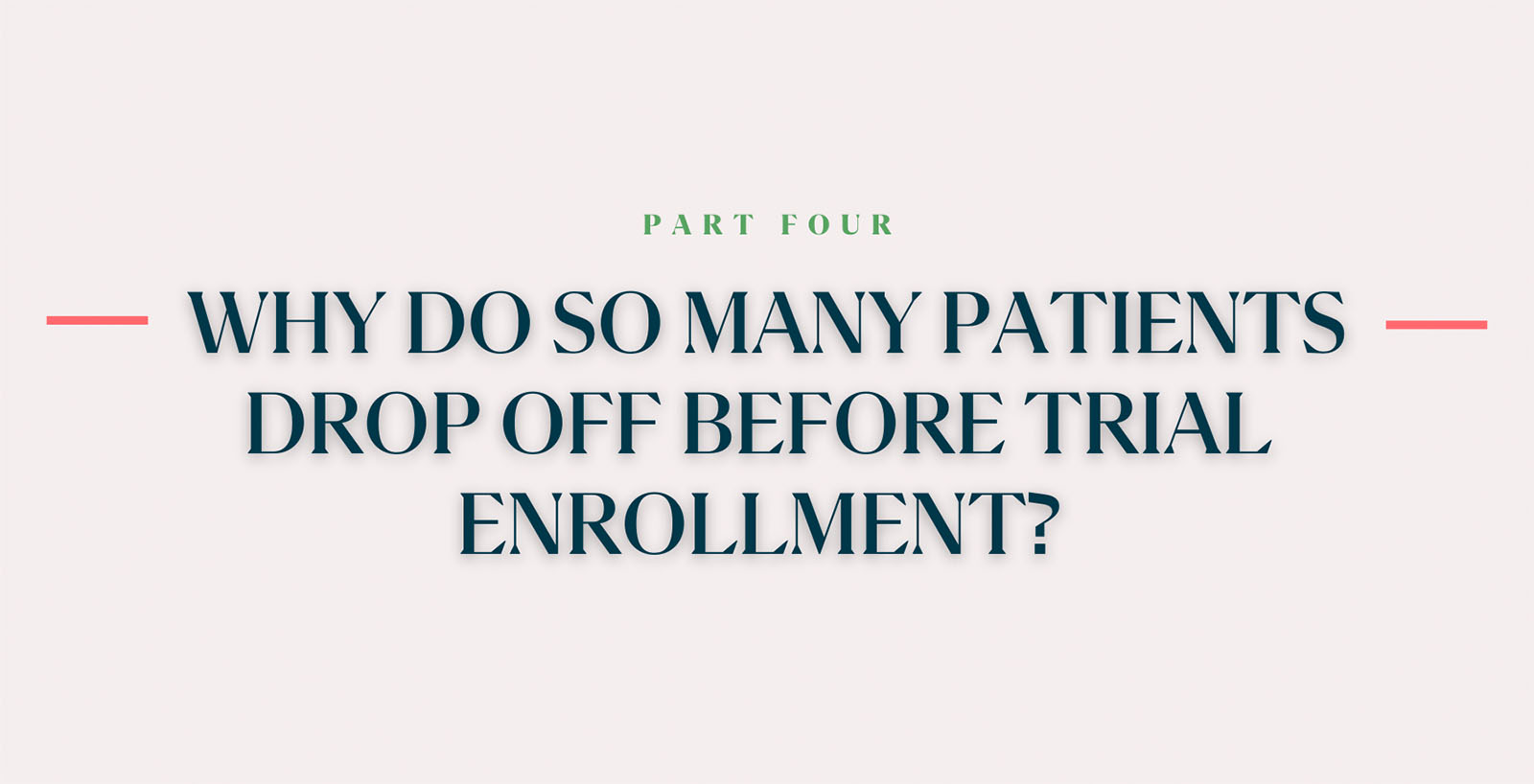January 28th, 2022
Why Do So Many Patients Drop Off Before Trial Enrollment?
By Reify Health

In our past three blogs on blind spots in clinical trial enrollment, we’ve discussed inefficiencies in patient recruitment and enrollment and solutions for optimizing recruitment of eligible trial participants. As we mentioned in our last part, one third of eligible study participants ultimately fail to enroll. So, what goes wrong, and what can we do to improve the experience for subjects and staff alike?
Moving forward, we’ll discuss:
- How various barriers may limit feasibility for patient participation in clinical trials
- What this means for accessibility and representation in clinical trials
- Why empowering clinical site staff can improve patient enrollment
Are we demanding too much of clinical trial participants?
While clinical trial subjects are often receiving care they need, they are ultimately providing a necessary service along the way. Sometimes it seems they’re asked to put in just as much time and effort as study staff. For example, a study of oncology trial participants showed that enrolled patients were traveling a median distance of 25.8 miles each way for trial participation. If we consider a study protocol that may have multiple trial-related visits each month—or even each week—this represents a major commitment of both time and money.
The first experience potential subjects have in a clinical trial is during the recruitment and enrollment process, making this a critical time to maximize efficiency and organization—not only to ensure data integrity, but also to show patients that trial participation will be worth their while. We’ve discussed how a transparent and comprehensive look into recruitment and screening data plays a role in guiding recruitment approaches. It also provides useful insight into changes that might make study participation more feasible for participants and maximize the number of potential candidates that ultimately enroll.
Inclusion/exclusion criteria
Inclusion/exclusion criteria are essential for enrolling a participant population that maximizes data integrity and patient safety. These guidelines are aimed at creating a study group that statistically matches the general patient population, but some criteria can create unforeseen limits in recruitment and ultimately favor a younger, healthier study sample (which has led a growing community of researchers to rethink the issue).
A comprehensive look at screening and enrollment data from subjects throughout a trial’s recruitment process can reveal restrictive eligibility criteria that may be holding eligible many patients back from enrollment. Some examples:
- Lab values: Lab tests are a foundational part of understanding patient health and monitoring safety in a trial. Most drug trials require lab values within a specific range at the time of screening in order to participate, but protocol specifications could overlook differences in ranges that exist between populations or with common conditions that may not interfere with the trial.
- Smoking status: Many studies restrict current smokers from participation and may also extend that restriction to former smokers within a certain window of quitting. While strict criteria around the habit are valuable for some studies, others could be positioned to be flexible if this is consistently limiting patient enrollment. For example, a trial that excludes subjects who were ever regular smokers may be able to extend to a quit time of 5 years prior or look carefully at their criteria for “regular smoking” without compromising study data.
- Allergies: While it is obviously unwise to open a drug trial to a subject that is allergic to the drug, some trials may exclude potential participants based on allergies to supportive care drugs noted in the protocol (such as a specific antibiotic recommendation). If this is a significant barrier to enrollment, examine the possibility of using alternative (but equally safe and effective) supportive therapies for patients with allergies.
Why patients decline to participate in clinical trials
Even when potential subjects meet a trial’s eligibility criteria, they still may choose not to enroll for various reasons. As we mentioned earlier in this chapter, many study activities place significant demands of time and energy on participants. For a protocol with frequent in-person study visits, it’s easy to imagine how the combination of travel costs and scheduling demands could easily render participation unfeasible for a potential subject.
Additionally, potential patients may lack a solid awareness or understanding of what a trial entails, creating hesitancy to participate. Here patient education efforts make a real difference. Providing clear, jargon-free literature that lays out the background, goals, and larger impact of a clinical trial, as well as providing opportunities to ask questions, can help patients feel secure in the decision to participate in a trial (and potentially encourage friends and family to do the same).
If they are comfortable providing it, collecting data on potential subjects’ reasons for declining to participate can inform solutions to overcome these issues in future recruitment efforts. For example, a more flexible visit schedule or a stipend for transportation to and from the clinical site could help patients who would otherwise be unable to participate. Overall, collecting and using this information is a valuable step in reaching the larger goal of making clinical trials accessible to the broadest population possible.
Why accessibility matters for the future of clinical trials
Maximizing diversity and inclusion in the clinical trial sphere is a growing priority of scientific agencies, as summarized in this 2020 announcement by the Food & Drug Administration. After all, the goal of developing any drug or medical device is to improve lives, and creating a product that is as safe and effective for the entire population it aims to reach is key.
Unfortunately, many of the barriers to study participation mentioned above also overlap with disparities in clinical trial representation. Remember that statistic about travel distances we cited earlier? The same study also found that patients from lower-income areas faced a significantly greater travel burden for trial visits (58.3 miles) than patients from higher-income areas (17.8 miles). When we consider the cost of traveling, as well as limitations related to work duties, caregiving responsibilities, or access to transportation, it’s easy to imagine how these disparities can be magnified.
Making trials more accessible for the widest patient population possible will take some effort and change. Integrating technology to collect and leverage data insights from recruitment and enrollment can illuminate barriers in your trial, and the growth of decentralized clinical trial technology will also play a major role in bridging these gaps.
Empowered site staff = empowered enrollment
In our previous blogs, we’ve discussed the administrative burdens placed on site staff that let patient referrals fall through the cracks. We know that supporting site staff workflows with better tools can increase trial performance, but it’s also worth considering how an empowered site staff can empower patient participation in turn. Clinical trial participation is often a complex and medically significant decision, so it’s easy to imagine how a stressed, harried, and overworked site workforce might shake patients’ confidence in the trial experience. Empowering site staff and minimizing their administrative burden can give them more time and energy to put focus where it matters—on quality of patient care.
Learn more about solving clinical trial enrollment challenges in our new ebook, Strategies to Fill Gaps in Patient Recruitment and Enrollment.
Related Posts

How Does a Trial Manager in Greece Improve Clinical Trial Operations with StudyTeam®?
Dimitris Tziogas, local trial manager at a biotechnology company in ...
Read More
How to Address Key Clinical Trial Challenges, According to Clinresco Centres in South Africa
There’s no single solution to overcoming a research site’s specific ...
Read More
3 Clinical Trial Billing Challenges Research Sites Solve with StudyTeam
Challenge 1: Complicated coverage analysis Challenge 2: Tedious budgeting ...
Read More
